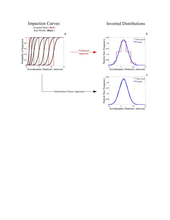Highlight
Cascade Impactor: A new approach to an old challenge
Achievement/Results
For more than 50 years the Cascade Impactor (CI) has been the standard device for the measurement of the distribution of aerodynamic diameters in an aerosol. CIs were originally designed for environmental/atmospheric studies as well as occupational health and safety work. More recently the pharmaceutical industry has begun to explore delivery of Active Pharmaceutical Ingredients (API) by inhalation of drug containing Aerosol Particles. Ideally, the function of a Cascade Impactor would be of great use for QA/QC methods in the production of such Active aerosol particles. However, CI, as currently designed, operate with a significant amount of variability. While this variability was acceptable for its original application, their use in the pharmaceutical industry dictates the need for a higher level of accuracy. Our work (described in detail below) uses a field of applied math known as Information Theory to propose a new method for analyzing CI data and perhaps even designing future devices.
Cascade Impactors operate by convecting an aerosol through several consecutive stages. Each stage of the Impactor is designed to retain all particles below a certain cutoff size. By arranging the stages in descending order of their cutoff sizes an incoming aerosol can be separated into size bins. The amount of mass within these size bins can then be used to estimate the original aerosol size distribution (as seen in Figure 1b). For each stage the relationship between the probability of a particle being captured and its aerodynamic diameter is known as an efficiency curve. Traditionally, each efficiency curves should be designed to be as near to a step function as possible. However, after more than 50 years of development even the most optimal efficiency curves do not approximate the ideal step function shape (Figure 1a). Furthermore, the relatively high air velocities necessary to insure the sharpest possible efficiency curves can cause the aerosol particles to bounce off of the impactors collection stages. This particle bouncing phenomena is dependent on the type of material impacting with the surface, which is one of the main reasons for variability in impactors. Without invariant ideal efficiency curves, interpreting the results of the impactor becomes complicated. In order to process the data, it has become a standard practice to assume that the point at which 50% of the mass will impact on each curve is actually the location of an ideal cutoff curve (as seen in contrast of the Red and Black curves Figure 1a). The error in this calculation is compounded by the uncertainty in the operation of the impactor.
The process of using the collection of discrete masses captured on the stages to estimate the original unknown particle size distribution is known as data inversion. The key aspect of data inversion is that the problems are ill-posed; that is, many possible different aerosol size distributions could lead to that specific configuration of captured masses in an impactor. While this aspect makes data analysis more challenging, it does not prevent a repeatable high quality inversion. Our approach has been to use Information Theory to find the most probable distribution given the information we have on the problem (collected stage masses and CI calibration information). Our key finding has been that when this mathematical technique is applied to CI inversion, certain configurations of non-ideal efficiency curves (namely efficiency curves which overlap with their neighbors) preserve more information and allow for an accurate reconstruction of the original size distribution (as seen in Figure 1c). This has two major implications (1) traditional design techniques are likely striving to design the worst impactor configuration from an Information Theory perspective and (2) if the shape of the impaction curves are allowed to be relaxed away from the ideal case (lower volicity, less steep efficiency curves), it is possible to design an impactor to minimize or eliminate particle bounce and other problems that cause the traditionally design impactors to have such variable behavior.
Address Goals
This activity is primarily aimed at discovering methodologies to make cascade impactors more accurate. The use of information theory as a novel approach for data inversion becomes also a mathematical tool for optimizing the design of these devices.
The activity also helps develop the research infrastructure of the country. By making cascade impactors more accurate, we provide an enhanced tool for improving the quality and accelerating the development of pharmaceutical products.






